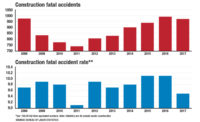Construction workplace fatalities continued to rise, reaching a 12-year-high in 2019 and the industry’s fatal-injury rate also turned upward, the Bureau of Labor Statistics has reported.
The BLS annual report on occupational deaths, released on Dec. 16, shows that private-sector construction fatalities climbed last year by about 5%, to 1,061.
BLS said that was the largest number of fatalities since 2007.
|
Year
|
Construction Fatalities
|
Fatality Rates*
|
|---|---|---|
| 2019 | 1,061 | 9.7 |
| 2018 | 1,008 | 9.5 |
| 2017 | 971 | 9.5 |
| 2016 | 991 | 10.1 |
| 2015 | 937 | 10.1 |
| 2014 | 899 | 9.8 |
| 2013 | 828 | 9.7 |
| 2012 | 806 | 9.9 |
| 2011 | 738 | 9.1 |
In addition, BLS figures show that construction’s fatality rate increased last year, to 9.7 per 100,000 full-time employees, from 9.5 in 2018 and 2017.
The injury rate is a key indicator of safety trends because it adjusts for annual changes in the number of workers and the volume of construction work.
Building Trades' Comments
Chris Trahan Cain, safety and health director for the North America’s Building Trades Unions (NABTU), told ENR by email, “The newly released fatality number is troubling, because each number represents a loved one lost to mostly controllable hazards on jobsites.”
Cain adds that an initial look at the BLS construction-specific numbers by researchers at CPWR-The Center for Construction Research “suggests that a sharp uptick in falls from heights may be the driver for the increase.”
The center is a nonprofit created by NABTU.
Cain says, “We will know more once we dig further in, but it is tragic that this well-understood hazard continues to claim so many construction workers’ lives.”
ABC, AGC comments
Greg Sizemore, Associated Builders and Contractors' vice president of health, safety, environment and workforce development, said via email, "This is a disappointing report and makes apparent that more work must be done in our industry to not only protect our employees from jobsite hazards but also improve the total human health of the construction workforce."
Sizemore adds, "Bottom line: One construction worker fatality is one too many."
He says ABC's annual safety performance report shows that "leadership is key to implementing and sustaining a safety culture in an organization."
Sizemore adds that ABC member companies that take part in the association's STEP Safety Management System "are more than eight times safer than the BLS industry average."
Brian Turmail, a spokesperson for the Associated General Contractors of America, said in an email that an AGC 2019 survey showed that “a significant percentage of firms reported worries that the infusion of new and relatively inexperienced workers was having an impact on construction safety.”
That development helped prompt AGC to join the National Construction Safety Week last year and to continue offering a variety of construction safety programs, Turmail says. AGC stepped up those efforts in 2020, he adds.
He says, “The bottom line is we need to constantly reinforce and enforce all safety measures and redouble our efforts to protect the health and safety of the industry’s workers.”
Turmail adds, “We have a lot of work to do, but will not rest until we get to zero fatalities."
For all industries and governmental bodies, BLS reports that the number of fatal injuries rose 2% in 2019, to a total of 5,333. The fatal-injury rate held steady at 3.5/100,000 full-time workers.
BLS noted that the 5,333 total was the highest annual level since 2007.




Post a comment to this article
Report Abusive Comment